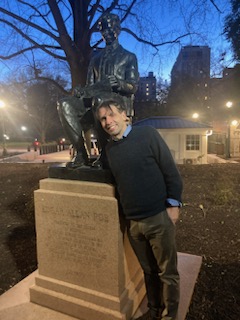As I Please: On Commemorating Edgar Allan Poe and “Norma Rae”

Today marks what would be the 215th birthday of writer and poet Edgar Allan Poe. His stories were so good I can remember where I was when I read them. At their best, they put your whole nervous system on high alert with their tales of death, subjectivity, rationality, and despair. “Tear up the planks!,” the villain tells the police in the last scene in the short story “The Tell-tale Heart.”
Rare among American writers, Mr. Poe captured the public’s imagination. Who else could have inspired the nickname, the NFL’s Baltimore Ravens, of a professional sports team? Who else could have prompted no fewer than four cities (New York, Boston, Baltimore, and Richmond, Viriginia) to honor him or his work with a statue?
Mr. Poe deserved the accolades. An orphan at age three, he produced more brilliant works in his forty years on earth than even greats like Mark Twain or Tom Wolfe, who lived twice as long. Witness “The Black Cat,” “The Telltale Heart,” “The Gold Bug,” “The Raven,” “The Pit and the Pendulum,” “The Purloined Letter,” “The Fall of the House of Usher,” “The Masque of the Red Death,” “The Cask of Amontillado,” and “The Murders in the Rue Morgue.” That’s ten, and not even including the novel Narrative of A. Gordon Pym, which is said to have inspired Herman Melville to write Moby Dick.
On Sunday, my family and I visited his statue in Richmond, Virginia. It stands eight- or nine-foot tall and features him sitting in a chair with a pen or quill in his right hand and a paper in his left. For a writer whose words could be electric, the statue is underwhelming.

Yes, to create the art he did he needed to sit down. I get it. Yet that was true for any writer until recently, not just a towering giant of American letters. I think a raven, a black cat, or a mask should have been on his shoulder or lap. That would be more apropos.
I was unable to visit his museum in Richmond, so perhaps the statue was an outlier. My daughters and I visited his museum in Baltimore eight years ago. It was a house that Mr. Poe lived in from 1832 to the fall of 1835 when he was in his early 20s.
It’s easy to envision yourself living in the house and has a fascinating and a scandalous backstory, so I recommend the tour to serious Poe fans. Ordinary tourists might be underwhelmed by not only the surrounding West Baltimore neighborhood but also the lack of a larger display of Mr. Poe’s work.
Poe’s statue in Boston is far more illustrative than the one in Richmond. It features the writer and poet standing mid-stride with a bird, perhaps a raven, perched on a briefcase he carries in his right hand. The statue captures the man in full, or as much as a statue can.
By no means have I seen all the Poe statues and artifacts, so please write in the comments below if you know more about them than I do.
Hollywood movies are criticized for being dark, contrived, manipulative, and trite. If you are looking for a film with none of those defects, I recommend “Norma Rae,” a movie that was popular when it came out, in 1979, but has been undeservedly forgotten since.
The film stars Sally Field as a working-class, Southern textile worker who struggles to maintain her and her family’s dignity in the face of corporate- and upper-class male mistreatment. Ms. Field won an Oscar in the best-actress category and her performance is something to write home about. She inhabited the character’s heart, mind, body, and soul so fully you forget this was the same actress who was made fun of for an earlier TV role or an unfortunate effusive remark after winning her second Oscar six years later.
Yet I thought the best part of “Norma Rae” was its theme of class solidarity.
Ms. Field’s character seeks relief from her plight not through the meritocracy as in J.D. Vance’s Hillbilly Elegy or moving away from her hometown as in the 1979 film “Breaking Away” but by forming a union.
Yes, a union: the mill workers’ wages and working conditions were pitiful, and the best way to improve them was through earning the right to collective bargaining. The movie drew criticism for conforming to union cliches, but unless I am being a sap, I found riveting the final scenes with Ms. Field’s character rallying the workers to organize and the final vote.
Without giving away the ending, I will say the film is gritty but hopeful, realistic, honest, and original. Those virtues may surprise movie watchers today, but they shouldn’t when you recognize the film was based on a 1975 book, Crystal Lee, A Woman of Inheritance.
Author Henry P. Leifermann interviewed the real Norma Rae, Crystal Lee Sutton, at length after her attempt to form a union became a national story. Perhaps Hollywood movies today wouldn’t get the rap they do today if more were based on journalistic accounts.
-30-

Mark, I’m glad we had a chance to visit this statue together. Your insight adds to the memories of a great way to spend the sabbath. Thank you for meeting me in Richmond. I enjoyed seeing the Arthur Ashe statue and this one, too.